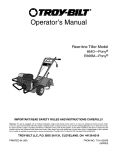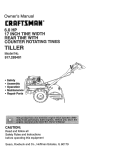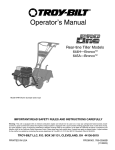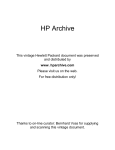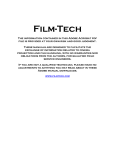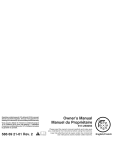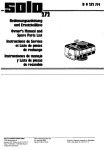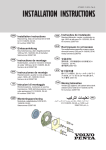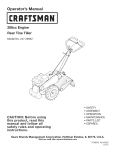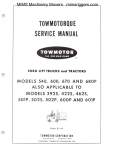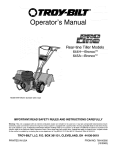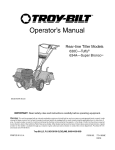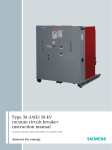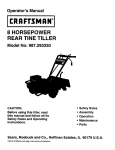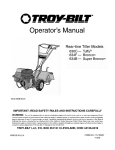Download Troy-Bilt 675B Tiller User Manual
Transcript
r® Operator's Manual Rear-tine Tiller Model 675B Model 675B Shown (bumper styles vary) IMPORTANT: WARNING: READ SAFETY RULES AND INSTRUCTIONS CAREFULLY This unit is equipped with an internal combustion engine and should not be used on or near any unimproved forest-covered, brush-covered or grass-covered land unless the engine's exhaust system is equipped with a spark arrester meeting applicable local or state laws (if any). If a spark arrester is used, it should be maintained in effective working order by the operator. In the State of California the above is required by law (Section 4442 of the California Public ResourcesCode). Other states may have similar laws. Federallaws apply on federal lands. A spark arrester for the muffler is available through your nearest engine authorized service dealer or contact the service department P.O. Box 361131 Cleveland, Ohio 44136-0019. TROY-BILT PRINTEDIN U.S.A. LLC, P.O. BOX 361131 CLEVELAND, OHIO 44136-0019 FORMNO. 769-00586B 9/13/04 TABLEOFCONTENTS Content Customer Support Safety Assembly Features and Controls Operation Page 2 3 6 9 11 Content Maintenance Troubleshooting Parts List Warranty Page 16 23 24 Back Cover FINDINGMODELNUMBER This Operator's Manual is an important part of your new lawn tractor. It will help you assemble, prepare and maintain the unit for best performance. Please read and understand what it says. Before you start assembling your new equipment, please locate the model plate on the equipment and copy the information from it in the space provided below. A sample model plate is also given below. You can locate the model plate by looking at the rear of the tine shield. This information will be necessary to use the manufacturer's web site and/or help from the Customer Support Department or an authorized service dealer. Copy the model number here: OTRDV-BILT Copy the serial number here: T,OV-BmLT LLC 361131 P. O. BOX www.troybilt.com CLEVELAND, OH44136 330-558-7220 ,. 1-800-520-552_ CUSTOMER SUPPORT Please do NOTreh/m the l/nit to theretailer withoutfirst contactingCustomerSupport. If you have difficulty assembling this product or have any questions regarding the controls, operation or maintenance of this unit, you can seek help from the experts. Choose from the options below: Visit troy-bilt.com for many useful suggestions. Click on Customer Support button and you will get the four options reproduced here. Click on the appropriate button and help is immediately available. /;/ ,> ..... j;_ ?" #'s ;'V }/ ) f ; F_ * ;,, #FOX }_ " 4t, ' @; i/!s t , j," ;D ,,, >,, _ 7>,,,,,v yO, rL;," ft, '_,-. , ¢j ,_ <# *x J ,_;7 f'_;:' ,7;; _ _tf';_'iv c ,l If you prefer to reach a Customer Support Representative, please call 1(800) 520-5520. The engine manufacturer is responsible for all engine-related issues with regard to performance, power-rating, specifications, warranty and service. Please refer to the engine manufacturer's Owner's/Operator's Manual, packed separately with your unit, for more information. SECTION1: SAFETY Wheel GearLever This machine meets voluntary safety standard B71.8-1996, which is sponsored by the Outdoor Power Equipment Institute, Inc., and is published by the American National Standards Institute. WARNING The engine exhaust from this productcontains chemicals known to the State of California to Reverse Clutch Control_ ForwardClutch Lever I / Recoil Rope Starter ForwardClutchLever Depth Regulator Lever cause cancer, birth defects or other reproductive harm. SafetyAlert Symbol ,_ in thisis manual the unit Ittoisalert This a safetyand alertonsymbol. used you to potential hazards. When you see this symbol, read and obey the message that follows it. Failure to obey safety messages could result in personal injury or property damage. 1. Carefully read this OwnTraining er's Manual, the separate Engine Owner's Manual, and any other literature you may receive.Be thoroughly familiar with the controls and the proper use of the tiller and its engine. Know how to stop the unit and disengage the controls quickly. 2. Neverallow children to operatethe tiller. Never allow adults to operatethe tiller without proper instruction. 3. Keepthe area of operation clear of all persons, particularly children and pets. 4. Keepin mind that the operator or user is responsible for accidents or hazardsoccurring to other people,their property, and themselves. Preparation 1. Thoroughly inspect the area where the tiller is to be usedand remove all foreign objects. 2. Be sure all control levers are released and the Wheel GearLever is in ENGAGEposition before starting the engine. 3. Do not operatethe tiller without wearing adequateouter garments. Avoid loose garments or jewelry that could get caught in moving parts. 4. Do not operatethetiller whenbarefootor wearingsandals,sneakers,or light footwear. Wearprotectivefootwearthat will improve footing on slipperysurfaces. 5. Donot till nearundergroundelectriccables, telephonelines,pipesor hoses.If in doubt, contactyour telephoneor utilitycompany. 6. Warning: Handlefuelwith care;it is highly flammableand its vaporsareexplosive.Take thefollowingprecautions: a. Store fuel in containers specifically designed for this purpose. b. Thegas capshall neverbe removed or fuel added while the engine is running. Allow the engine to cool for several minutes before adding fuel. c. Keepmatches, cigarettes, cigars, pipes, open flames, and sparks away from the fuel tank and fuel container. d. Fill fuel tank outdoors with extreme care. Neverfill fuel tank indoors. Use a funnel or spout to prevent spillage. CounterRotatingTines Figl/re 1-1 e. Replaceall fuel tank and container caps securely. f. If fuel is spilled, do not attempt to start the engine, but move the machine away from the area of spillage and avoid creating any source of ignition until fuel vapors have dissipated. 7. Nevermake adjustments when engine is running (unless recommended by manufacturer). Operation 1. Do not put hands or feet near or under rotating parts. 2. Exerciseextreme caution when on or crossing gravel drives, walks, or roads. Stay alert for hidden hazards or traffic. Do not carry passengers. 3. After striking a foreign object, stop the engine, remove the wire from the spark plug wire and prevent it from touching the spark plug, thoroughly inspectthe machine for any damage, and repair the damagebefore restarting and operating the machine. 4. Exercisecaution to avoid slipping or falling. 5.Iftheunitshould starttovibrate abnormally, a. Walk behind and to one side of the stoptheengine, disconnect thespark plug tiller, usingone handon the hanwireandprevent itfromtouching thespark dlebars. Relax yourarm, but use a plug, andcheck immediately forthecause. Visecure handgrip. bration isgenerally awarning oftrouble. b. Use slower engine speeds. 6.Stoptheengine, disconnect thespark c. Clear the tilling area of all large stones,rootsand other debris. plugwireandprevent itfromtouching the sparkplugwhenever youleave theoperat- d. Avoid usingdownwardpressureon ingposition, before unclogging thetines, handlebars.If need be, use slight orwhenmaking anyrepairs, adjustments upwardpressureto keepthe tines orinspections. from diggingtoo deeply. 7.Take allpossible precautions whenleav- e. Beforecontacting hard packedsoil at the end of a row, reduce engine ingthemachine unattended. Stoptheenspeed and lift handlebarsto raise gine.Disconnect sparkplugwireandmove tines out of the soil. itawayfromthesparkplug.Move Wheel GearLever toENGAGE. f. In an emergency, stop tines and wheels by releasingwhichever 8.Before cleaning, repairing, orinspectClutchLever is engaged. Do not ating,stoptheengine andmake certain all tempt to restrain the tiller. moving partshave stopped. Disconnect 15. Do not overloadthe tiller's capacity by thesparkplugwireandprevent itfrom touching thesparkplugtoprevent acci- attempting to till too deeply at too fast a rate. dental starting. 9.Always keep thetillertinehoodflap 16. Never operate the tiller at high transdown. port speeds on slippery surfaces. Look behind and use care when backing up. 10.Never usethetillerunless proper guards, plates, orother safety protective de- 17. Donot operatethe tiller on a slope that vices areinplace. is too steep for safety. When on slopes, 11.Donotrunengine inanenclosed area. slow down and make sure you have good Engine exhaust contains carbon monoxide footing. Neverpermit thetiller to freewheel gas,adeadly poison thatisodorless, col- down slopes. orless, andtasteless. 18. Never allow bystanders near the unit. 12.Keep children andpetsaway. 19. Onlyuse attachments and accessories 13. Neveroperate the tiller underengine power if the Wheel Gear Lever is in DISENGAGE(FREEWHEEL).In this position, the wheels will not hold the tiller back and the revolvingtines could propel the tiller rapidlybackward,possiblycausing loss of control. Always move the Wheel Gear Leverto ENGAGEbefore starting the engine or engaging the tines4Nheelswith the Forward Clutch or the ReverseClutch. 14. Be aware that the tiller may unexpectedly bounce upward or jump backward if the tines should strike extremely hard packed soil, frozen ground, or buried obstacles like large stones, roots, or stumps. If in doubt about the tilling conditions, always usethe following operating precautions to assist you in maintaining control of the tiller: that are approved by GardenWay Inc. 20. Usetiller attachments and accessories when recommended. 21. Neveroperatethetiller without good visibility or light. 22. Neveroperatethetiller if youaretired, or underthe influenceof alcohol,drugsor medication. 23. Operatorsshallnottamperwith theenginegovernorsettingsonthemachine;thegovernor controlsthemaximumsafeoperatingspeedto protectthe engineandall movingpartsfrom damagecausedby overspeed.Authorizedserviceshallbesoughtif a problemexists. 24. Donottouchenginepartswhich maybe hot from operation.Letpartscooldown 25. Pleaseremember:Youcanalwaysstopthe tinesandwheelsby releasingtheForward ClutchLeveror theReverseClutchControl (whicheverleveryou haveengaged)or bymoving theThrottleControlLeverto STOP. 26. Toloador unloadthetiller,seethe instructions in Section4 ofthis Manual. 27. Useextremecautionwhenreversingor pullingthe machinetowardsyou. 28. Starttheenginecarefullyaccordingto instructionsand with feetwellawayfrom the tines. 29. Neverpick upor carrya machinewhilethe engineis running. MaintenanceandStorage 1. Keepthe tiller, attachments and accessories in safe working condition. 2. Checkall nuts, bolts, and screws at frequent intervals for proper tightness to be sure the equipment is in safe working condition. 3. Neverstorethetillerwith fuelin thefueltank insidea buildingwhereignitionsourcesare presentsuch ashot waterandspaceheaters, furnaces,clothesdryers,stoves,electricmotors,etc.).Allowengineto coolbeforestoringin anyenclosure. 4. Toreducethechancesof a firehazard,keep theenginefreeof grass,leaves,or excessive grease. 5. Storegasoline in a cool, well-ventilated area,safelyaway from any spark- or flameproducing equipment. Store gasolinein an approvedcontainer,safelyaway from the reachof children. 6. Referto the storage instructions in the Maintenancesection of this Manualand the separateEngineOwner's Manualfor instructions if the tiller is to be stored for an extendedperiod. 7. Neverperform maintenancewhile the engine is running orthe spark plug wire is connected,exceptwhen specifically instructed to do so. 8. If the fuel tank hasto be drained,do this outdoors. SafetyDecals ControlDescription (on ControlPanel) For your safety and the safety of others, various safety and operational decals are located on your unit (seeFigure 1-2 be- low). Keepthe decals clean and legible at all times. Contactyour local service dealer or the factory for replacements if any decals are damagedor missing. Refer to the Parts List in this manual for TineWarning StartingStabilization Message(on engine) decallocations, part numbers and ordering instructions. WarningMessages (onlinehood) HotSurfacesMovingBelts Warning(onbeltcover) Figure 1-2: Locationof Safety and OperatingDecals OperatingSymbols Various symbds(shownhere, withworddescriptions) mayheusedon'dle'dllerand engine. NOTE: Yourunitmaynothaveallof_esymbds. I-.-I I,I CHOKE ON CHOKE OFF R REVERSE <-FAST SLOW STOP TILLERDIRECTION LEVERDIRECTION TO AVOID SERIOUS INJURY: READTHE OPERATOR'SMANUAL. KNOWLOCATIONSAND FUNCTIONSOF ALLCONTROLS. KEEPALLSAFETYDEVICESANDSHIELDSIN PLACEAND WORKING. NEVERALLOWCHILDRENOR UNINSTRUCTEDADULTSTO OPERATETILLER. SHUTOFF ENGINEAND DISCONNECTSPARKPLUGWIRE BEFOREMANUALLYUNCLOGGINGTINES OR MAKINGREPAIRS. . KEEPBYSTANDERSAWAYFROM MACHINE. . KEEPAWAYFROM ROTATINGPARTS. ° USEEXTREMECAUTIONWHEN REVERSINGOR PULLINGTHE MACHINETOWARDS YOU. * * * . ° ROTATING TINES SECTION2: ASSEMBLY WARNING: HardwareBag PartsList To prevent personal injury or property damage,do not start the engine until all assembly steps are complete and you have read and understand the safety and operating instructions in this Manual. Introduction Carefully follow these assembly steps to correctly prepare your tiller for use. It is recommendedthat you readthis Section in its entirety before beginning assembly. Ref. Qty. 1 2 3 4 2 1 1 1 5 6 7 8 9 18 11 2 2 2 2 2 1 4 Unpacking and Assembly Instructions STEP1:UNPACKINGINSTRUCTIONS 1. Removeany card-board inserts and packaging material from the carton. Remove any staples from the bottom of the carton and remove the carton. 2. Cut the large,plastic tie strap that securesthe transmissiontube to the shipping pallet. Leavethe handlebarson top of the tiller to avoid damagingany cables. 3. A bag with loose hardware is inside the literature envelope. Checkthe contents against the following list and Figure 2-1. Contact your local dealer or the factory if any items are missing or damaged. NOTE:For electric start units, a second hardware bag is located near the battery. 4. The tiller is heavy.You should not attempt to remove it from the shipping platform until instructed to do so in these "Assembly" steps. 3/8-16 x 1" Hex Hd. Screw KeyedWasher Wheel Gear Lever Knob Height Adjustment Flange (See Figure 2-2) 3/8" Flat Washer #10 Lockwasher 3/8"-16 Nylock Lock Nut #10-32 x 1/2" Rnd Hd Screw #10-32 Nut Cotter Pin (not used) Plastic Tie Strap (2 not used) O@ 7 4 8 10 11 Figure2-1: Loosehardware(shownin reducedsize). Tools/ MaterialsNeeded Inspect unit Inspect the unit and carton for damageimmediatelyafter delivery.Contactthe carrier (trucking company) if you find or suspect damage. Inform them of the damageand request instructions for filing a claim. To protect your rights, put your claim in writing and mail a copy to the carrier within 15 days after the unit has been delivered. Contact us at the factory if you need assistance in this matter. Description for Assembly (1) (2) (1) (1) (1) (1) 3/8" open-end wrench* 9/16" open-end wrench* 7/8" open-end wrench" Scissors (to trim plastic ties) Ruler Small board (to tap plastic knob on lever) (1) Tire pressure gauge (1) Cleanoil funnel (1) Clean,high-quality motor oil. Referto the separate Engine Owner's Manual for motor oil specifications and quantity required. * Adjustable wrenches may be used. IMPORTANT: Motor oil must be added to the engine crankcase before the engine is started. Follow the instructions in this "Assembly" Section and in the separate Engine Owner's Manual. Figure2-2: Handlebar heightadjustmentuses the flange head screw. Figure2-3: Forwardclutchcontrolcablenot shownforclarity. 3. With the forward clutchcable (N, Figure 2-4) on the inside of handlebar,position the handlebar ends on the outside of NOTE: LEFT and RIGHT sides of the tiller are as viewed from the the two mounting tabs (M, Figure 2-3) on the transmission top cover. operator's handlebars. NOTE:The curved handlebar height adjustment bracket appearsas shown in C, Figure 2-3 for non-electric start units. For position behind the STEP2: ATTACHHANDLEBARS 1. Cut the large, plastic cableties that secure the handlebarends to the handlebar mounting tabs on the transmission top cover. 2. Gently lift handlebar (do not overstretch attachedcable) and placehandlebar crossbrace (B, Figure 2-3) in front of curved height adjustment bracket (C). electric start units, the bracket is loosened and moved to one side. 4. Loosely attach the handlebarsto the mounting tabs with two 3/8-16 x 1"screws (headsof screws go to inside of tabs), 3/8" flat washers and 3/8"-16 lock nuts (O, Figure 2-4). IMPORTANT: Usethe DISENGAGE position only when the engine is not running. Before starting the engine,the WheelGear Levermust be placedin the ENGAGEposition (see Section 3 for details). STEP3: ATTACHREVERSECLUTCH CONTROLCABLE Figure2-4: Attach handlebars. 5. Move the handlebars up or down to align the threaded hole in the cross-brace with one of the four slots in the curved height adjustment bracket. Placethe keyed washer (E, Figure 2-3) on the flange head height adjustment screw (F) with the raised keys (edges) of the washer facing down. 6. Threadthe height adjustment screw (F, Figure 2-3) into the hole in the handlebar cross-brace, making sure that the raised keys on the washer fit into the slot on the height adjustment bracket. Tighten the height adjustment screw securely. Next, securely tighten the two screws and nuts in the ends of the handlebar (M, Figure 2- 3). 7. To remove the tiller from its shipping platform, first carefully unwrap the wheel gear cable (with attached lever- see Figure 2-5) from around the chassis. Move the Wheel Gear Lever (G) to the DISENGAGE position--this allows the wheels to rotate freely. Usethe handlebarsto roll the tiller off the platform. 1. Carefully unwrap the reverse clutch control cable (H, Figure 2-6) from its shipping position and route it up along the inside edge of the left side handlebar.A knob and large hex nut (I) is installed on the cable. Left Side Handlebar Reverse Clutch Control Knob Figure2-7: Forward ClutchControllevers (J). Forwarddutch control linkage (K). 2. The forward clutch control cable (with attached spring) is hanging loosely near the right-side wheel. Being careful not to kink or stretch the cable, insert the z-connector (L, Figure 2-8 - end of the spring) into the hole at the end of the forward clutch control linkage (K, Figure 2-7). Slot in ControlPanel '1 Figure2-6:Attachreverseclutchcontrolassemblytodotted holein handlebarpanel. 2. Insert the cable into the slot in the control panel and fit the threaded assembly into the hole in the slot (seeFigure2-6). Be sure that the flat side of the threaded assembly is aligned with the flat side of the hole. Slide the hex nut (I) up the cable and tighten it securely. 3. Testthe function of the reverse clutch control cable by pulling the knob out and releasing it. The knob should return to its neutral position against the tapered bushing. If it doesn't, contact your local dealer or the factory for technical. Figure2-8 3. Attach the cable adjuster (A, Figure2-9) to the bracket on the right-side handlebar. Use two 1/2"wrenches to loosen the two jam nuts (B)just enough to slide the cable adjuster onto the bracket. Then hand tighten the jam nuts. STEP4: ATTACHFORWARDCLUTCH CONTROLCABLE 1. Removeany fasteners (rubber bands, tape, etc.) that may secure the Forward Clutch Control levers (J, Figure 2-7) to the handlebar. Figure2-5: CarefullyunwrapWheelGearLeverand moveleverto DISENGAGE. NOTE: The Wheel Gear Lever will be installed later in this procedure. Figure2-9 CAUTION: Incorrect cable adjustment could cause the wheels and tines to rotate unexpectedly.Follow adjustment procedures carefully. Failureto do so could result in personal injury or property damage. 4. Checkfor correct spring/caNe tension as instructed in Section 5, Checkingand Adjusting Forward Clutch Belt Tension. 5. Whentension is correct, tighten the two jam nuts (B) securely. STEP5: CHECKTRANSMISSIONGEAR OIL LEVEL Thetransmission was filled with gear oil at the factory. However,be sure to check the oil level at this time to make certain it is correct. IMPORTANT: Do not operatethe tiller if the gear oil level is low. Doingso will result in severe damageto the transmission components. 1. With the tiller on level ground, pull the Depth Regulator Lever (R, Figure 2-13) back and then slide it to the second notch from the top. NOTE:If the lever does not move, lift the tine hood flap and look for a plastic tie securing the lever in place. Cut and remove the tie. 2. Removethe oil level check plug (M, Figure 2-10) on the left-side of the transmission. (Due to dried paint on the plug threads, it may require some force to remove the plug the first time.) Thegear oil level is correct if oil starts to flow out ofthe hole as the plug is removed. If so, securely reinstall the plug. Figure 2-10: Gear oil level checkplug. Figure2-11:Addinggearoil. NOTE: Do not use automatic transmission fluid or motor oil in the transmission. (a) Cleanarea around the fill hole (N, Figure 2-11) and unscrew gear oil fill plug. (b) If adding only a few ounces of gear oil, use API rated GL-4 or GL-5 gear oil having a viscosity of SAE 140, SAE85W-140 or SAE 80W-90. If refilling an empty transmission, useonly GL-4 gear oil having a viscosity of SAE 85W-140 or SAE140. (c) Using a clean funnel, slowly add gear oil until it flows from the gear oil level check hole (N, Figure 2-11). (d) Reinstall and tighten securely the gear oil fill plug (M, Figure 2-10). STEP6: ATTACHWHEELGEARLEVER 1. Insert the WheelGear Lever (P,Figure 212) upthrough the slot in the control panel that is labeled "WHEELGEAR." 2. Insert two #10-32 x 1/2" round head screws downthrough the'%" marks on the control panel decaland securely attachthe wheel gear mounting bracket using two #10 lock washers and #10-32 nuts. 3. Use a small board or rubber mallet to tap the Wheel Gear Lever knob securely onto the lever (R, Figure 2-13). 4. Securethe wheel gear cable and the reverse clutch control cable to the left-side handlebar with two plastic ties (S, Figure 2-13) locatedabout two feet apart. Snip off any excess tie length. STEP7: CHECKAIR Use a tire pressure gauge to check the air pressure in both tires. Deflateor inflate both tires equally to between 15 PSi and 20 PSI. Besure that both tires are inflated equally or the unit will pull to one side. 3. If oil does not flow from the check hole, add oil as follows: Figure2-12: Attach Wheel Gear Lever. Figure2-13:Attachwheelgearcableand reverseclutchcablewithcableties(S). STEP8: CHECKHARDWARE Inspectthe hardware on the unit and tighten any loose screws, bolts and nuts. SECTION3: FEATURES ANDCONTROLS _ IMPORTANT:The Forward Clutch Levers are connectedto a mechanical interlock operating your machine, ARNING: Before carefully readand understand all safety, controls and operating instructions in this Manual, the separateEngine Owner's Manual,and on the decals on the machine. Failure to follow these instructions can result in serious personal injury. Tiller Features Figure3-1: Controlpanel. This section describes the location and function of the controls on your tiller. Refer to Section 4: Operationfor detailed operating instructions. To shift to ENGAGE,gently (do not force) move the lever forward while rolling the tiller a few inches forward or backward. Practice using these controls, with the engine shut off, until you understand the operation of the controls and feel confident with each of them. IMPORTANT:Referto the separateengine manufacturer's EngineOwner's Manual for information about the controls on the (Moving the tiller helps align the transmission shift mechanism). Thewheels will not freewheel when the lever is properly set in the ENGAGEposition. To shift to DISENGAGE,move the lever rearward, without rolling the tiller. The wheels roll freely when the lever is properly set in the DISENGAGEposition. engine. ForwardClutchLevers Wheel Gear Lever Two interconnected levers (B, Figure3-1) control engagementof the forward driveto the wheels and powerto the tines. This lever (A, Figure 3-1) hastwo positions: ENGAGEand DISENGAGE. In the ENGAGEposition, the wheels will start turning when either the Forward Clutch or the ReverseClutch is engaged. NOTE: The tines will also start turning when either clutch is engaged. ,_ Wheel GearLever in DANGER: Neverplacethe DISENGAGE(Freewheel)when the engine is running. Having the Wheel Gear Leverin engaging the tines_vheelswith either the Forward Clutchorthe ReverseClutch could allow the tines to propel the tiller rapidly backward. Failureto follow this instruction could result in personal injury or property damage. The DISENGAGE(freewheel) position places the wheels in freewheeling mode to allow the wheels to turn without starting the engine. Use the DISENGAGEposition only when the engine is not running. ,_ wheels and tines Never with Forward WARNING: engage Clutch or ReverseClutch unless Wheel GearLever is in ENGAGE.Engagingthe Forward Clutch or ReverseClutch when wheels are not engaged could allow the tines to rapidly propel tiller backward. Failureto follow this warning could result in personal injury or property damage. To OperateForwardClutch: 1. Before engaging the Forward Clutch, put the Wheel Gear Leverinto the ENGAGE position (see "WARNING"above). 2. Lift and hold one or both levers against the handlebar grips to engagethe wheels and tines. 3. ReleaseBOTHlevers to disengage wheels and tines. All forward motion will stop (engine will continue to run). that automatically shifts a separateWheel Gear Lever (A, Figure3-1) into ENGAGE position when either Forward Clutch Lever is pulled up against the handlebars. This is a safety feature designedto prevent the wheels from being in DISENGAGE (freewheel) position when the tines are rotating. Beforestarting the engine, test the function of the mechanicalinterlock as follows: 1. Put Wheel Gear Lever into DISENGAGE position and roll tiller back and forth a few inches. Wheels should roll freely. 2. Without rolling the tiller, squeezeeither Forward Clutch Leveragainst the handlebar grips. As the levers move upward, the mechanical interlock automatically moves the Wheel GearLever forward into the ENGAGEposition (roll tiller back and forth a few inches). If it does, the wheels will not roll freely when you push and pull on the handlebars. 3. The mechanicalinterlock works properly if it functions as described in Step 2. If the mechanical interlock does not function properly, do not operatethe tiller until it has been corrected (seeyour authorized dealer or contact the factory). Reverse Clutch Control This control (C, Figure 3-1) engagesthe reversedrive to the wheels and power to the tines. It is usedfor moving the tiller short distances in a reverse direction. ToOperateReverseClutch: _ caution when reversing or ARNING: Useextreme pulling the machine towards you. Look behind to avoid obstacles. Never attempt to till in reverse.Failureto follow this warning could result in personal injury or property damage. 1. Beforeengaging the ReverseClutch, put the Wheel Gear Lever into ENGAGE.(see "WARNING" at left). 2. Releasethe Forward Clutch Levers. 3.Tomove thetillerinreverse, firststopall Handlebar HeightAdjustment forward motion. Liftupthehandlebars un- Handlebar height is adjustable to four diftil thetinescleartheground andpullthe ferent settings. When setting the height, Reverse Clutch leverout. keep in mind that the handlebars will be Thewheels willrotate inareverse direction lower when the tines are engaged in the aslongastheleverisheldinREVERSE. To soil. stopthewheels andtines,release thelever WARNING: Whenever the anditwillreturn toNEUTRAL. Neverattempt to till while movingin reverse direction. handlebar height is changed, the Forward Clutchshift mechanism must be DepthRegulatorLever readjusted. Beforeadjusting or checking the Forward Clutch mechanism, shut engine off, disconnect spark plug wire and prevent it from touching spark plug. Failureto follow this warning could cause the Forward Clutch mechanism to operateimproperly which could result in personal injury or property damage. This lever (E, Figure 3-2) controls the tilling depth of the tines. Pull the lever straight back and slide it up or down to engage the notched height settings. EngineControls IMPORTANT:The engine is equipped with either a choke control or a primer bulb. Refer to the Engine Owner's Manual (included in tiller literature package)to identify which device is on your engine. Recoil Starter The recoil starter (H, Figure3-4) is usedto "pull-start" the engine. SeeEngine Starting and Stopping in Section 4 for detailed engine starting instructions. H To AdjustHandlebarHeight: Figure3-2: DepthRegulatorLever. The highest notch (lever all the way down) raisesthe tines approximately 1-1/2 inches off the ground. This "travel" position allows the tiller to be moved without the tines digging into the ground. 1. Stop engine, wait for all parts to stop moving and then disconnect spark plug wire. 2. Loosenthe two screws at lower ends of handlebar. 3. Loosenheight adjustment screw (F,Figure 3-3) and pull keyedwasher (G) free from slots in curved height adjustment bracket. Moving the lever up increasesthe tilling depth. The lowest notch allows a tilling depth of approximately six to eight inches, depending on soil conditions. For best results, always begin tilling at a very shallow depth setting and gradually increase tilling depth. Regulator Leverin "travel" WARNING: PlaceDepth position before starting engine. This position preventsthe tines from touching the ground until you are readyto begin tilling .Do not attempt to till too deeplytoo quickly. Graduallywork down to deepertilling depths. Failure to follow this warning could result in personal injury or property damage. ,_ Figure3-3: Handlebar height adjustment. 4. Move handlebarsto a new slot setting and insert the raised key on the keyed washer into the slot. Tighten the height adjustment screw securely. 5. Retighten the two screws at ends of handlebar. lO Figure 3-4: Recoil starter handle. EngineThrottle Lever Thethrottle lever (D, Figure3-1 ) is usedto adjust engine speedas well as stop the engine. Use the STARTposition when starting the engine. Pull the lever all way back to the STOPposition to shut the engine off. SECTION3: OPERATION WARNING: Before Reverse ClutchControl operating your machine, carefully readand understand all safety (Section 1), controls (Section 3) and operating instructions (Section 4) in this Manual, in the separate Engine Owner's Manual,and on the decals on the machine. Failure to follow these instructions can result in serious personal injury. Break-In Operation Perform the following maintenanceduring the first hours of new operation (see Section 5: Maintenanceand the maintenance section of the Engine Owner's Manual). 1. Changemotor oil after first 2 hours of new engine operation. 2. Checkfor loose or missing hardware on unit. Tighten or replaceas needed. 3. Checktension on forward drive belt after first 2 hours of operation. 4. Checktransmission gear oil level after first 2 hours of operation. STARTING AND STOPPING ENGINE The following steps describe how to start and stop the engine. Do not engage the tines or wheels until you have read all of theoperatinginstructionsin thisSection. Alsoreview the safety rules in Section1: Safetyand the tiller and engine controls informationin Section3: Featuresand Controls. Pre-StartChecklist Do the following before starting the engine. 1. Checkunit for looseor missing hardware. Service as required. / ForwardClutchLever \ ForwardClutchLever Recoil Rope Starter Depth Regulator Lever Introduction Readthis Section of the manual thoroughly beforeyou start the engine. Then, take time to familiarize yourself with the basic operation of the tiller before using it. Find an open, levelarea and practice using the tiller controls without engaging the tines in the soil (put tines in "travel" setting). Only after you've become completely familiar with the tiller should you begin using it in the garden. WheelGearLever CounterRotatingTines Figure4-1 2. Checkmotor oil level. See Engine Owner's Manual. 3. Checkthat all safety guards and covers are in place. 4. Checkair cleanerand engine cooling system. See Engine Owner's Manual. 5. Select a forward belt speed range (see ChangingBelt SpeedRanges in this Section). 6. Fill the fuel tank with gasoline according to the directions in the separate Engine Owner's Manual. Follow all instructions and safety rules carefully. _k HIGHLYFLAMMABLEAND ANGER: GASOLINEISITS VAPORSAREEXPLOSIVE. Follow gasoline safety rules in this manual (seeSection 1) and in the separate Engine Owner's Manual. Failureto follow gasolinesafety instructions can result in serious personal injury and property damage. _, serious personal injury AUTION: To helpor prevent damageto equipment: • Beforestarting engine,put WheelGear Leverinto ENGAGE position. • Beforestarting engine,put Forward ClutchLeversand ReverseClutchControl intoneutral (disengaged)positions by releasingcontrols. • Neverrun engineindoorsor in an enclosed,poorlyventilatedarea.Engine exhaustcontainscarbonmonoxide,an odorlessand deadlygas. • Avoid enginemufflerand nearbyareas. Temperaturesin theseareasmay exceed 150oF. 3. Put the Depth Regulator Lever into the "travel" position (lever all the way down) so that the tines are clear of the ground. 4. Releaseall controls on the tiller. 5. If the engine is equipped with a fuel shutoff valve, turn the valve to the open position, as instructed in the separate Engine Owner's Manual. 7. Attach spark plug wire to spark plug. Startingthe Engine _ 1. Completethe Pre-Start Check/isL 2. Put the Wheel Gear Lever(Figure 4-1 ) into the ENGAGEposition. 11 from rotating tines. Rotating WARNING: Keep away tines will cause injury. 6. Move the EngineThrottle Leverinto the STARTposition. 7. Choke or prime the engineas instructed in the separate Engine Owner's Manual. 4. For forward motion of the wheels and power to the tines: 8. Checkbehind you to avoid contacting (a) Pull up and hold the Forward Clutch levers againstthe handlebars.Tostop the wheels and tines, releaseboth leve rs. WARNING: any obstacles when pulling the starter rope. Placeone hand on the fuel tank to stabilize the unit and usethe recoil starter to start the engine as instructed in the Engine Owner's Manual. Whenthe engine starts, gradually move the choke lever (on enginesso equipped)to the NO CHOKE, CHOKEOFFor RUNposition, whicheverapplies. 9. Use the FASTthrottle speed setting when tilling. StoppingtheEngine 1. Tostop the wheels and tines, releasethe Forward Clutch levers or the Reverse Clutch Control (whichever control is in use). 2. Tostop the engine, move the Engine Throttle Lever into the STOPposition. OperatingTiller _ contact your telephone and ARNING: Beforetilling, utilities company to inquire if underground lines are on your property. Thefollowing pages provide guidelines to using your tiller effectively and safely in various gardening applications. Be sure to read Tilling Tips & Techniquesin this Section beforeyou actually put the tines into the soil. 1. Follow the Pre-Start Checkl/ston the previous page.Besure that the Wheel Gear Lever is in the ENGAGEposition. 2. Movethe Depth Regulator Leverintothe "travel" position (leverall the way down) so that the tines clearthe ground. Usethis position when practicing with or transporting the tiller. When you are readyto begin tilling, move the Depth Regulator Lever into the desired depth setting (see Tilting Tips & Techniques). 3. Start the engine and allow itto warm up. Whenwarm, move the throttle control into the FASTspeed setting. Donot push down on the handlebarsto try to make the tiller till more deeply. This preventsthe wheels from holding the tiller back and can allow the tines to rapidly propel the tiller backwardtoward the operator, which could result in loss of control, property damage, or personal injury. (b) Asthe tiller movesforward, relaxand let the wheels pull the unit along while the tines dig. Walk behind and a little to one side of the tiller. Use a light but secure grip with one hand on the handlebars, but keepyour arm loose. See Figure 4-2. Letthe tiller move ahead at its own pace. Do not push down on the handlebarsto try and force the tiller to dig deeper- this takes weight off the wheels, reduces traction, and causesthe tines to try and propel the tiller. 5. For reverse motion of the wheels and tines: Figure4-2: Useonehandtoguide tiller when movingforward. Figure4-3: Raisetinesoffgroundandlookbehindwhenmovinginreverse. (a) Look behind and exercisecaution when operating in reverse.Do not till while in reverse. (b) Stop all forward motion before reversing. Lift the handlebars with one hand until the tines are off the ground and then pull the ReverseClutch control out (seeFigure 4-3). Tostop reverse motion, let go of the Reverse Clutch Control. 6. Toturn the tiller around: (a) Practice turning in a level, open area. Be very careful to keepyour feet and legs away from the tines. (b) To start a turn, reduce the engine speedand then lift the handlebars until the engine and tines are balanced over the wheels (Figure 4-4). (c) With the tiller balanced, push sideways on the handlebar to move the tiller in the direction of the turn (Figure 4-5). After completing the turn, slowly lower the tines into the soil and increase the engine speed. 12 Figure 4-4: Find balancepoint before turning. Figure 4-5 StoppingtheTiller andEngine 6. Checkthat the belt is within the forward 1. Tostop the wheels and tines, releasethe Forward Clutch levers or the Reverse Clutch Control (whichever is engaged). beltguide (E, Figures4-10 and 4-11) on the right-side of the unit and is within the forward idler (F,Figure 4-11) on the left-side. Besure that the belt is situated in the center grooves (C and D, Figure 4-10) of the engine (upper) and transmission (lower) pulleys. 2. Tostop the engine, move the Engine Throttle Lever to STOR 3. If the engine is equipped with a fuel shutoff valve,close the valve as instructed in the Engine Owner's Manual. _k changing belt speeds,stop WARNING: Before engine,wait for all parts to stop moving, let engine cool and disconnect spark plug wire. Failureto follow these instructions could result in personal injury. ChangingBelt RangeSpeeds Thetiller hastwo forward belt rangespeeds for the wheels and tines: Low and High. The two rangesare obtained by moving the forward drive belt between two sets of grooves on the forward drive pulley and the transmission drive pulley. NOTE:The High speed belt range is recommended for all tilling purposes. The Low speed belt range will operate the tines and wheels at a slower forward speed, which may be suitable in some conditions (such as tilling in very hard ground). ToChangefrom Lowto HighSpeed: 1. Stopthe engine, allow it to cool, and disconnect the spark plug wire. 2. Move the Wheel Gear Lever into the DISENGAGEposition. 3. Removethe two nuts from the plastic belt cover on top of the transmission and remove the belt cover. 4. From beneaththe tiller, move the forward drive belt out of the transmission low speed groove (B, Figure 4-10) and into the high speed groove (D). 5. Pull upward on the belt to remove any slack and slip the belt out of the engine drive pulley low speed groove (A, Figure410) and into the high speedgroove (C). ,c l (Low) (High) everse Belt 7. Reinstallthe plastic belt cover and secure it with the two nuts. 8. Put Wheel Gear Leverin ENGAGEand reconnect spark plug wire before attempting to start the engine. To Changefrom Highto LowSpeed: 1. Stop the engine,allow it to cool, and disconnect the spark plug wire. 2. Put Wheel Gear Lever in DISENGAGE. 3. Removethe two nuts from the plastic belt cover on top of the transmission and remove the belt cover. 4. From beneaththe tiller, move the forward drive belt out of the transmission pulley high speed groove (D, Figure 4-10) and into the low speed groove (B). (Low) (High) Figure4-10:Right-sideview ofengineand transmission pulleys (engineisatright-side of view). 5. Pull upward on the belt to remove any slack and slip the belt out of the engine drive pulley high speed groove (C, Figure41O)and into the low speed groove (A). NOTE:If the belt is difficult to move, pull on the engine start rope while pushing the belt with your finger (engine drive pulley will turn as start rope is pulled). 6. Checkthat the belt is within the forward belt guide (E,Figures4-10 and 4-11) on the right-side of the unit and is within the forward idler (F,Figure 4-11) on the left-side. Be sure that the belt is situated in the rear grooves (A and B, Figure4-10) of the engine (upper) and transmission (lower) pulleys. 7. Reinstallthe plastic belt cover and secure it with the two nuts. 8. Put the Wheel Gear Lever in ENGAGE and reconnect the spark plug wire before attempting to start the engine. NOTE:If the belt is difficult to move,pull on the engine start rope while pushing the belt with your finger (engine drive pulley will turn as start rope is pulled). 13 Figure4-11: Topview offorwarddrivepulley system(engineis at left-sideof view). TILLINGTIPS& TECHNIQUES Tilling Depths WAHNING: This is a CRT(counter-rotatingtine) tiller. As the wheels pull forward, the tines rotate backward. This createsan "uppercut" tine action which digs deeply,uprooting soil and weeds. Don't overloadthe engine,but dig as deeplyas possible on eachpass. On later passes,the wheelsmaytendto spinin thesoft dirt. Helpthem along by lifting up slightly on thehandlebar (one hand,palm up,works most easily). Before tilling, contact your telephone or utilities company and inquire if underground equipment or lines are usedon your property. Do not till near buried electric cables, telephone lines, pipes or hoses. Avoidthe temptation to pushdown on the handlebarsin an attemptto force thetiller to dig deeper.Doingso takesthe weight off the poweredwheels,causingthem to lose traction. Withoutthe wheelsto hold the tiller back,the tineswill attempt to propelthe tiller backward, towardsthe operator.(Sometimes,slightdownward pressureon the handlebarswill help get througha particularlytough sectionof sod or unbrokenground, but in most casesthis won't be necessary.) • Whencultivating (breakingup surfacesoil around plants to destroyweeds,seeFig.4-9), a just the tines to dig only 1"to 2" deep.Using shallow tilling depths helps prevent injury to plants whose roots often grow close to the surface. If needed,lift up on the handlebars slightly to preventthetines from diggingtoo deeply.(Cultivatingon a regularbasisnot only eliminatesweeds,it alsoloosensand aerates thesoil for better moistureabsorptionandfaster plantgrowth.) Wateringthegardenareaa few days prior to tilling will maketilling easier, aswill letting the newly worked soil set for a dayor two beforemakinga final, deeptilling pass. ChoosingCorrectWheel & Tine Speeds With experience,you will find the "just right" tilling depth and tilling speedcombination that is best for your garden. Setthe enginethrottle leverat a speedto givethe engineadequatepowerand yet allow it to operateat the slowest possiblespeed...atleast until you haveachievedthe maximum tilling depth you desire. Fasterenginespeeds may be desirablewhen makingfinal passesthrough the seedbedor whencultivating. Selectionof the correct enginespeed,in relationto the tilling depth, will ensurea sufficientpower levelto do the job without causingthe engine to labor. Let the Tiller Dothe Work AvoidMaking Footprints Whiletilling, relaxand letthe wheelspull the tiller along while the tines do the digging. Walk on the side that is not yet finished (to avoid makingfootprints in the freshly tilled soil) and lightly, but securelygrip the handlebarwith just one hand. AvoidTilling Soggy,Wet Soil Whenever possible, walk on the untilled Tilling wet soil often results in large,hard sideof the unit to avoid makingfootprints in clumps of soil that can interfere with plantyour freshly tilled or cultivated soil. Foot- ing. If time permits, wait a day or two after prints causesoil compaction that can ham- heavy rains to allow the soil to dry before per root penetration and contribute to soil tilling. Testsoil by squeezingit into a ball. If erosion. They can also "plant" unwanted it compressestoo easily,it is too wet to till. weed seeds back into the freshly tilled ground. Preparing Seedbeds • Whenpreparinga seedbed,go overthe samepathtwice in thefirst row,then overlap one-halfthetiller width on the rest of the passes(seeFig. 6). Whenfinished in one direction,make a second pass at a right angle,as shown in Fig.4-7. Overlap eachpassfor best results (in very hardground, it may takethree or four passesto thoroughly pulverizethe soil.) Fig. 4-6 Fig.4-7 Cultivating • If the gardensize will not permit lengthwiseand thencrosswisetilling, then overlapthefirst passesby one-halfa tiller With planning, you can ==.._vp. ==_._ v_ allow enoughroom _" _ (_ width,followed by successivepasses at one-quarterwidth (seeFig.4-8). between rows to cultivate _ _ (seeFig.4-9). Leaveroom _ for the hood width, plus enough extra _ _ .................... v ................................. _ _ Fig. 4-8 room for future plant growth. 14 _' Fig. 4-9 TILLINGTIPS & TECHNIQUES (CON'T) Tilling On Slopes Read the followingrecommendationsbeforetilling on slopes: WAHNING: If you must gardenon a moderateslope,pleasefollow two very importantguidelines: 1. Till only on moderateslopes,neveron steepground wherefooting is difficult (review safety rulesin Section 1: Safetyof this manual). 2. We recommendtilling up and down slopes ratherthan terracing. Tilling vertically on a slopeallows maximum plantingarea and also leavesroomfor cultivating. IMPORTANT: Whentilling on slopes, be surethe correct oil levelis maintainedin the engine (checkevery one-half hour of operation).The inclineof the slopewill causethe oil to slant awayfrom its normalleveland this can starveengineparts of requiredlubrication. Keepthe motor oil levelat the full point at all times! Do not operatetiller on a slope too steep for safe operation. Till slowly and be sure you have good footing. Neverpermit tiller to freewheel down slopes. Failureto follow this warning could result in personal injury. Tilling Up and DownSlopes(Vertical Tilling) • To keepsoil erosionto a minimum, be sureto add enough organicmatterto the soil sothat it has good moisture-holdingtexture and try to avoid leavingfootprints or wheelmarks. • Whentilling vertically,try to makethe first passuphill as thetiller digs moredeeplygoing uphillthan it doesdownhill. In soft soil or weeds, you may haveto lift the handlebarsslightly while going uphill. Whengoing downhill, overlapthe first passby aboutone-halfthe width of the tiller. Clearingthe Tines Thetines havea self-clearingactionwhicheliminatesmosttanglingof debrisin the tines.However,occasionallydrygrass,stringystalksor toughvinesmaybecometangled.Followthese proceduresto helpavoidtanglingandto cleanthe tines,if necessary. •Toreducetangling,setthedepthregulatordeepenoughto getmaximum"chopping" actionas thetines chopthe materialagainstthe ground.Also,try to till undercrop residuesor covercropswhilethey aregreen,moistandtender. • Whiletilling, try swayingthe handlebarsfrom sideto side (about6"to 12").This "fishtailing"actionoften clearsthe tinesof debris. • If tanglingoccurs,lift thetines out of the soiland run thetiller in reverse(if unit is equippedwith poweredreverse)for a few feet.Thisreversingactionshouldunwinda gooddealof debris. Loading and UnloadingtheTiller ,_ unloadingthetiller Loading intoavehicleis WARNING: and potentiallyhazardousandwedon't recommenddoingso unless absolutelynecessary, asthiscould resultin personalinjuryor propertydamage. However,if you mustloador unloadthetiller, followthe guidelinesgivennext. • Beforeloadingor unloading,stopthe engine, waitfor all partsto stop moving, disconnectthe sparkplugwireand letthe engineand mufflercool. • Thetiller is too heavyandbulkyto lift safely by oneperson.Twoor morepeopleshould sharethe load. • It may be necessaryto remove the debris by hand (a pocket knife will help you to cut awaythe material). Be sure to stop the engine and disconnect the spark plug wire before clearing the tines by hand. tines by hand, stopBeforeclearing the engine,allow WARNING: theall moving parts to stop and disconnect the spark plug wire. Removethe ignition key on electric start models. Failureto follow this warning could result in personal injury. • Use sturdy ramps and manually (engine shut off) roll the tiller into and out of the vehicle. Two or more people are neededto do this. • When going up ramps, stand in the normal operating position and push the tiller ahead of you. Havea person at each side to turn the wheels. • The ramps must be strong enoughto support the combined weight of the tiller and any handlers. The ramps should provide good traction to prevent slipping; they should have side rails to guide the tiller along the ramps; and they should havea locking device to secure them to the vehicle. • When going down ramps, walk backward with the tiller following you. Keepalert for any obstacles behind you. Position a person at eachwheel to control the speed of the tiller. Nevergo down ramps tiller-first, as the tiller could tip forward. • Placewooden blocks on the downhill side of • The handlersshould wearsturdy footwearthat will helpto preventslipping. • Position the loading vehicle so that the ramp angle is as flat as possible (the less incline to the ramp, the better). Turn the vehicle's engine off and apply its parking brake. 15 the wheels if you needto stop the tiller from rolling down the ramp. Also, use the blocks to temporarily keep the tiller in place on the ramps (if necessary),and to chock the wheels in place after the tiller is in the vehicle. • After loading the tiller, prevent it from rolling by engaging the wheels in the WHEELDRIVE position. Chock the wheels with blocks and securely tie the tiller down. SECTION5: MAINTENANCE D ,_ serious personal injury or property damage. MAINTENANCESCHEDULE PROCEDURE NOTES Chock motor oil level 2, 3 Clean engine Check drive belt tension Check nuts and bolts Change motor oil Lubricate tiller 2, 7 1,4 1,4 1,4, 6 4 Service foam pre-cleaner air filter Service paper air filter Check gear oil level in transmission Check tines for wear 7 7 1, 5 5 Check air pressure in tires Service spark plug 5 7 NOTES 12 - After first 2 hours of break-in operation. Before each use. 3 - Every5 operating hours. 4 5 - Every 10 operating hours. Every30 operating hours. 6 - Changemore frequently in dusty or dirty conditions. 7- See Engine Owner's Manual forservice recommendations. Whichever time interval occurs first. 8 - lation either on the unit or on the floor L E inspecting, cleaning or WARNING: Before servicing the machine, shut off engine, wait for all moving parts to come to a complete stop, disconnect spark plug wire and move wire away from spark plug. Removeignition key on electric start models. Failureto follow these instructions can result in where it has been parked. A little seepagearound a cover or oil seal is usually not a cause for alarm. However, if the oil drips overnight, then immediate attention is needed--ignoring a leak can result in severe transmission damage. Figure5-1 • Removetines and clean tine shafts (C, Figure 5-1). Inspect for rust, rough spots or burrs (especiallyaround holes). File or sand smooth and coat ends of shaft with grease. • Oil the threads on the handlebar height adjustment handle (D, Figure 5-1). • Oil the outer casings of the engine throttle cable and the wheel gear cable (E, Figure5-1). Allow oil to soak in and then wipe off any excess. • Oil the various pivot points (F, Figure 52) on the shifting mechanism, the handlebar,and the idler arms (do not allow oil on the belts or pulleys). If a cover leaks, try tightening any loose screws or bolts. If the fasteners are tight, a new gasket or oil seal may be required. If the leak is from around a shaft and oil seal, the oil seal probably needsto be replaced. Seeyour authorized dealer or contact the factory for service or advice. IMPORTANT:Never operatethe tiller if the transmission is low on oil. Checkthe oil level after every 30 hours of operation and whenever there is any oil leakage. CheckHardware Checkthe unit for loose or missing hardwareafter every 10 operatinghours. Loose or missing hardwarecan lead to equipment failure, poor performance, or oil leaks. Besure to check the three end cap mounting screws located at the rear of the transmission (Figure 5-3). Lift the tine flap to service those screws. Tiller Lubrication Proper lubrication of the tiller is an essential part of your maintenanceprogram. After every 10 operating hours, oil or grease the lubrication points shown in Figures 51 and 5-2 and described below. Use general purpose lubricating oil (#30 weight motor oil is suitable) and a general purpose grease (metal lubricant is preferred, if available). • Removewheels and cleanwheelshaft (A, Figure 5-1). Apply a thin coating of greaseto shaft before reinstalling wheels. • Greaseback, front and sides of depth regulator lever (B, Figure 5-1). EndCap Figure5-2 Check Tire Air Pressure Checkthe air pressure in both tires. Deflate or inflate both tires evenly to between 15 and 20 PSi (pounds per square inch). Be sure that both tires haveequal air pressure or the unit will pull to one side. Check For Oil Leaks Beforeeach use, checkyour tiller for signs of an oil leak--usually a dirty, oily accumu16 Figure5-3 Transmission Gear Oil Service Checkthe transmission gear oil level after every 30 hours of operation or whenever you notice any oil leak. Operatingthe tiller when the transmission is low on oil can result in severe damage. moving parts to come to a completecleaning stop, disconnect spark wire and move wire away WARNING: Beforeinspecting, or servicing theplug machine,shut off engine, waitfrom for all spark plug. Failureto follow these instructions can result in serious personal injury or property damage. A. ToCheckTransmission 1. Checkthe gear oil level when the transmission is cool. Gear oil expands in warm operating temperatures and will result in an incorrect oil level reading. 2. Tocheck the gear oil level (and to add oil, if necessary), refer to STEP5."Check GearOil Level in Transmissionin Section 2 of this manual. D.To Drainand Refillthe Transmission: Thetransmission gear oil does not need to be changedunless it has been contaminated with dirt, sand or metal particles. 1. Prop upthe left side of the unit securely. Removethe left-side wheel by removing the wheel mounting hardware. 2. Unscrew the plastic gear oil fill plug from the top of the transmission 3. Placea clean pan below the transmission drain plug (Figure5-4) and remove the drain plug. Theoil will start flowing out of the drain hole (it may flow slowly, especially in cold temperatures). 7. Use a clean funnel to slowly add SAE 140 or SAE85W-140 weight gear oil (with an API rating of GL-4 only) to the transmission. Thetransmission holds approximately 3-1/4 pints (52-54 ounces). Tilt the tiller slightly backwards to make sure the gear oil reachesthe rear (tine) end of the transmission. Stop adding gear oil when it begins to flow from the oil levelcheck hole on the side of the ion. 8. Securely reinstall the oil level check plug. 9. Securely reinstall the gear oil fill plug on top of the transmission. 10. Reinstall the wheel and remove the prop. Engine Oil Service Checkthe motor oil level before starting the engine eachday and after each5 hours of continuous operation. Running the engine when the oil level is low will quickly ruin the engine. Air CleanerService The engine air cleaner filters dirt and dust out of the air before it enters the carburetor. Operatingthe engine with a dirty, clogged air filter can cause poor performance and damageto the engine. Never operatethe engine without the air cleaner installed. Inspect and service the air cleaner more often if operating in very dusty or dirty conditions. Service the air cleaner as instructed in the separate Engine Owner's Manual. inspectand cleanor replacethe spark plug after every 100 operating hours or annually. Cleanthe plug and set the gap as described in the separate Engine Owner's Manual. It is recommendedthat you changethe motor oil after every 10 hours of operation and even sooner when operating in extremely dirty or dusty conditions. In some areas, local law requires using resistor spark plugs to suppress ignition signals. If the engine was originally equipped with a resistor spark plug, use the same type for replacement. A. To Checkthe Motor0il Level: SparkArrester Screen Service 1. Move the tiller to a level area and stop the engine. If the engine muffler is equipped with a spark arrester screen, remove and clean it according to the time intervals and instructions in the separate Engine Owner's Manual. Figure 5-4: Remove drain plug to drain transmissiongear oil (also remove oil fill plug and oil level checkplug). 3. Cleanthe area around the oil dipstick or oil fill tube (whichever applies) to prevent dirt from falling into the crankcase. 4. Removethe transmission gear oil level check plug that is located a few inches abovethe left-side wheel shaft (N, Figure 2-11). 4. On engines with an oil fill tube, remove the filler cap and add oil (if required) until it reachesthe top of the tube. Reinstallthe filler cap. 5. On engines with a dipstick, remove it, wipe it clean, and reinstall it finger4ight. Removethe dipstick again and check the reading. Add oil (if required) to bring the level to the FULL mark. Do not overfill. 6. After draining the oil, clean the threads of the drain plug, apply a non-hardening, removable gasket sealant to the threads, and securely reinstall the drain plug. Changethe motor oil as instructed in the separate Engine Owner's Manual. Spark Plug Service 2. Levelthe engine by moving the Depth Regulator Lever into the second notch from the top. 5. When the oil stops flowing, tilt the transmission forward to drain oil from the rear of the transmission. B. To Changethe Motor Oil: 17 EngineCleaning The engine must be kept clean to assure smooth operation and to prevent damage from overheating. Refer to the separate Engine Owner's Manualfor specific repair and cleaning instructions. All inspections and services must be done with the engine shut off and cool to the touch. moving parts to come to a completecleaning stop, disconnect spark wire and move wire away WARNING: Beforeinspecting, or servicing theplug machine,shut off engine, waitfrom for all spark plug. Failureto follow these instructions can result in serious personal injury or property damage. NOTE: Carburetor / Governor Adjustment The tiller hood must be removed to take off either a single tine holder or individual tines. The hood is ,_ shall not tamper with the engine WARNING: Operators governor settings; the governor controls the maximum safe operating speedto protect the engine and all moving parts from damagecaused by overspeed.Authorized service shall be sought if a problem exists. Thecarburetor was adjusted at the factory for best operating speed. Referto the separate Engine Owner's Manualfor any adjustment information or seeyour authorized engine service dealer. The governor controls the maximum safe operating speed and protects the engine and all moving parts from damagecaused by overspeeding. Do not tamper with the engine governor settings. Seekauthorized service if a problem exists. Throttle Control Adjustment If the engine does not respond to various throttle lever settings, referto the separate Engine Owner's Manualfor service information or contact your local authorized engine service dealer. Wheel Gear Cable Adjustment When the Wheel Gear Lever is in DISENGAGE,the wheels will roll freely (freewheel). The wheels should not roll freely when the lever is in ENGAGE.If the wheels roll freely when the Wheel Gear Lever is in ENGAGE,the wheel gear cable needsto be adjusted as described below. 1. With the engine shut off and the spark plug wire disconnected, put the Wheel Gear Lever in ENGAGE. 2. Loosen the top adjustment nut the wheelgear cable bracketlocated on the left side rear of the transmission. 3. Push wheelgear cable (B) down and roll tiller slightly forward or backward until eccentric lever (C) engages (locks) wheels. Hold cable in that position and tighten top (A) and bottom (D) adjustment nuts. secured to the transmission housing with two rear bolts and two front bolts. Tine Inspection Figure5-5: Wheel gear cable assembly. 4. MoveWheel Gear Leverto ENGAGEand DISENGAGEseveral times to check adjustment. The wheels should not roll when the lever is in ENGAGE,but they should roll when the leveris in DISENGAGE.Readjust the cable as required. With use, the tines (Figure 5-6) will become shorter, narrower and pointed. Badly worn tines will result in a loss of tilling depth and reducedeffectiveness when chopping up and turning under organic matter. Removing andInstalling Off SeasonStorage Whenthe tiller won't be used for extended periods, prepare it for storage as follows: 1. Cleanthe tiller and engine. 2. Do routine tiller lubrication (see Tiller Lubrication) and check for loose parts and hardware (see CheckHardware). 3. Protect the engine by performing the engine storage instructions in the separate Engine Owner's Manual. NOTE:Besure to protect the fuel lines, carburetor and fuel tank from gum deposits by removing fuel or by treating fuel with a fuel stabilizer (follow engine manufacturer's recommendations). 4. Store unit in a clean, dry area. 5. Neverstore the tiller with fuel in the fuel tank in an enclosed area where gas fumes could reach an open flame or spark, or where ignition sources are present (space heaters, hot water heaters, furnaces, etc.). Tines Thetines will wear with use and should be inspected at the beginning of eachtilling seasonand after every 30 operating hours. Tines can be replacedindividually or as a complete set. Neverinspect or servicethe tines unless the engine is stopped and the spark plug wire is disconnected. 18 Figure5-6: Fourfine gangs:two per side. 1. Use a 9/16" socket, 6" extension, a ratchet, and a 9/16" box wrench to loosen the nut (A, Figure5-7) and bolt (B) that secure the tine holder to the tine shaft. 2. Use a rubber mallet to tap the tine holder loose. 3. Slide the tine assembly off the tine shaft. 4. Repeat Steps 1-through-3 above to remove the other tine assembly. 5. Installing the tine assembly is simply the reverse of its removal. Besure the cutting edges face so they will enter the soil first whenthe tiller is moving forward- this meansthe cuttingedgesface towardthe operator position. First be sure to remove any rust, uneven spots or burrs from the tine shaft, using fine sandpaper.Then greasethe tine shaft before reinstalling the tine assemblies. Tighten the hardware very securely. moving parts to come to a completecleaning stop, disconnect spark wire and move wire away WARNING: Beforeinspecting, or servicing theplug machine,shut off engine, waitfrom for all spark plug. Failureto follow these instructions can result in serious personal injury or property damage. ,_ ToCheckandAdjustTension onthe Forward DriveBelt: 1. Checkingfor correct belttension is the same as that described in item 5, Step 4: Attach Forward ClutchRod. Beforecheck- C D SHAFT ENGINE I_ OFENOTES TINE CUTTING EDGE 2. Disconnectthe Forward Clutch Rod (A, Figure 5-9) from the swivel plate (B) by removing the innermost hairpin cotter (C). I Figure5-7: Completetineassemblies--holders, tinesand hardware. _b (counter-rotating tine)istiller ARNING: This a CRT and its tines must be mounted in the direction shown in Figure5-7. Failureto comply could result in personal injury or property damage. 2. When installing individual tines, install them in the reverseorder from which they were removed.The two sets of inboard tines are installed so one fine faces toward the transmission housing and the other fine faces away from it. The single outboard tine on each side facestoward the transmission housing. Also be sure the cutting edges face so they will enter the soil first when the tiller is moving forward-this meansthe cuttingedgesface toward the operator position. CheckingAndAdjustingTension On DriveBelts While checking belt tension, also check for cracks, cuts or frayed edges. A belt that is in poor condition should be replaced. ing, shut off the engine, disconnect the spark plug wire, and allow the engine and muffler to cool down. If, after following the adjustment procedures, you cannot get the correct gap on the forward clutch rod adjustment bracket, you will needto make a secondary adjustment as described next. _ beltARNING: adjustment instructions Follow the carefully. An incorrect adjustment could result in the Forward Clutch mechanism engaging too soon. This could cause loss of tiller control and result in personal injury or property damage. Maintaining correct tension on the drive belts is important to good tilling performance and long belt life. A loose belt will slip on the engine and transmission pulleys and cause the tines and wheels to slow down - or stop completely - even though the engine is running at full speed. A loose belt will also result in premature wear to the belt. Thetension on a new forward drive belt should be checkedafter the first two (2) hours of operation. Thereafter, check the tension after every ten (10) hours of operation. The reverse drive belt, becauseit is used infrequently, will not require an initial tension adjustment until a significant number of operating hours has passed. 19 3. Unthreadthe Forward Clutch Rod (in a counterclockwise direction as viewed from the front of the unit) until one or two threads on the rod extend abovethe rectangular nut (D, Figure5-10) on the forward clutch bracket. 4. Removethe belt cover. 5. Slip the forward drive belt (E, Figure he engine-driven forward drive pulley by pushing it off (away from engine) with your left hand while pulling engine starter rope with your right hand. 6. On the left side of the unit (from operator's position) removethe hairpin cotter from the clevis pin (F,Figure 5-11) that connects the forward idler arm (G) to the forward adjustable link (H). Push inward on the forward idler arm (G) and remove the clevis pin (F). 7. Thereare two holes in the forward adjustable link (H, Figure5-11). Push inward on the forward idler arm (G) and install the clevis pin (F)through the inner hole in the forward adjustable link (H) and out through the single hole in the forward idler arm (G). Securethe clevis pin with the hairpin cotter. ,_ C moving parts to come to a completecleaning stop, disconnect spark wire and move wire away WARNING: Beforeinspecting, or servicing theplug machine,shut off engine, waitfrom for all spark plug. Failureto follow these instructions can result in serious personal injury or property damage. (E) Removebelt NOTE: While pushing inward on the forward idler arm, be sure that the forward drive belt is moved off to the right side of the tiller. This creates more room to install the clevis pin when the forward idler arm is 3ushed inward. IMPORTANT:When the clevis pin Is installed in the inner hole of the forward Figure 5-9: Disconnect ForwardClutch Rod and move forward drive belt out of groove in engine forward drive pulley. adjustable link, the number of additional belt tension adjustments are limited. If, with future tension adjustments, you find that you cannot screw the forward clutch rod any farther into the rectangular nut on the forward clutch bracket, it means that the forward drive belt must be replaced. Beforedoing so, the clevis pin must be returnedto the OUTSIDEhole in the forward adjustable link. 8. Replacethe forward drive belt in the High speed groove (groove closest to engine) or the Low speed groove (rearmost) groove of the engine drive pulley and in the matching groove of the transmission pulley. Be sure the belt is to the inside of the wire formed belt guide (I, Figure5-12) and to the inside of the forward drive idler pulley (J). Figure 5-10: One or two threads on Forward Clutch Rod should he exposed above rectangular nut. Figure5-13 To Checkand AdjustTensionon the Reverse Drive Belt: 1. Removethe belt cover after first shutting off the engine, disconnecting the spark plug wire, and allowing the engine and muffler to cool down. 2. Stand at the front of the tiller and use your left hand to push the reverse idler arm (K, Figure 5-13) inward as far as possible (the reverse idler pulley [L] is attached to the reverse idler arm). Hold the idler arm in this position and look at the position of the belt tension guide mark (M, Figure5-14) that is stamped into the face of the reverseadjustable link (N, Figure 5-14). • The tension is correct if the guide mark (M, Figure5-14) is anywhere to the left of the guide pin (0), as viewed from the Figure 5-12: Topview of belts and pulleys. 9. Reinstallthe belt cover and secure it with the two nuts. Figure5-11: Remove clevispin from outer hole in forwardadjustable link and move to inner hole in link. 10. Readjustthe forward drive belt tension by following the instructions in Section 3: HandlebarHeight Adjustment. 2O Figure5-14: While pushing reverse idler arm #lward, standat engineendandcheckpositionof guidemark (M) andguidepin (0). moving parts to come to a completecleaning stop, disconnect spark wire and move wire away WARNING: Beforeinspecting, or servicing theplug machine,shut off engine, waitfrom for all spark plug. Failureto follow these instructions can result in serious personal injury or property damage. front of the unit (not the operator's position). If the belttension is correct, reinstall the belt cover and secure it with the two nuts. the belt is located to the inside of the re9. Reinstallthe belt cover and secure it with the two nuts. A. Removing the ForwardDriveBelt: • If the guide mark is aligned with the guide pin, or movesto the right side of the guide pin,then the belt is too loose and the tension must be readjusted as described next. IMPORTANT: If, in future tests for reverse belttension, the guide mark should again align with or move to the right side of the guide pin, it means that the reverse belt is worn beyond adjustment. Beforeinstalling a new belt, you must return the clevis pin to the OUTSIDEhole in the reverseadjustable link. following the Removing the ReverseDrive Beltinstructions in this section. 3. The reverseidler pulley (L, Figure5-13) regulatesthe tension that is applied to the reverse drive belt (P). The following adjustment will allow the reverseidler pulley to apply more tension to a loose belt. 4. Removethe belt cover. 5. Slip the reverse belt (P,Figure5-13) off the engine-driven reverse (upper) pulley. 6. On the right side of the unit (asviewed from operator's position), removethe hairpin cotter from the clevis pin (R, Figure 513) that connects the reverse idler arm (K) to the reverseadjustable link. Push inward on the reverse idler arm (K) and remove the clevis pin (R). 7. There are two holes in the reverse ad- verse idler pulley (L, Figure 5-13). Forward Drive Belt Removal and Installation This model has two forward speeds (High FRONT.-II_ D B belt range; the rearmost groove is for the Low speedforward belt range. 1. Stop the engine,allow it to cool and disconnect the spark plug wire before working near the belts. 2. Removethe reverse drive belt 3. Move the forward drive belt (B, Figure 5-16) completely off the engine forward drive pulley (D). 4. Slip the forward drive belt completely off the transmission drive pulley (C, Figure 5-16) by moving it to the front of the pulley. 5. Pull the forward drive belt up and off the pulleys by feeding the bottom half of the belt in betweenthe engine and transmission pulleys. B. Installingthe ForwardDriveBelt: 1. The reversedrive belt must be removed before installing the forward drive belt. 2. Slip the forward drive beltdown between the rear of the engine forward drive pulley (D, Figure5-16) and feedthe bottom half in betweenthe engine and transmission pulleys (see Figure5-17). Besure that the belt is to the inside of the forward idler pulley and forward belt guide (seeJ and I, Figure 5-12). justable link (S, Figure5-15). Push inward on the reverse idler arm (K) and install the clevis pin (R)through the inner hole in the reverseadjustable link (S) and out through the single hole in the reverseidler arm (K). Securethe clevis pin with the hairpin cotter. 8. Reinstallthe reversebelt (P,Figure5-13) on the reverse (upper) pulley, making sure Figure5-16: Belt drivesystem. Figure5-15:Installing clevispin ininsidehole ofreverseadjustable link. and Low) and one reverse speed. The forward engine pulley (D, Figure 5-16) has two grooves for the two forward speeds. The reverse engine pulley (A, Figure5-16) has one groove for the one reverse speed. The transmission pulley (C, Figure 5-16) has three grooves. The groove closest to the engine is for the reverse belt. The middle groove is for the High speed forward Figure5-17: Install forwarddrive belt over rear of engine forwardpulley and bring lower haft of belt down and in frontof transmission pulley. 21 moving parts to come to a completecleaning stop, disconnect spark wire and move wire away WARNING: Beforeinspecting, or servicing theplug machine,shut off engine, waitfrom for all spark plug. Failureto follow these instructions can result in serious personal injury or property damage. 3. Slip the forward drive belt down and over the front of the transmission pulley (C, Figure 5-16). NOTE:For additional working room, loosen the reverse belt guide (V, Figure 5-12) and twist it out of the way. 4. Put the lower half of the belt into the C FRONT-IP 4. Push the upper half of the reverse belt downward to create slack in the belt. Then reachunderneath the transmission and High speed groove (middle groove) or the Low speed groove (rearmost groove) of the transmission pulley (C, Figure 5-16). slip the belt off the front of the transmission pulley (B, Figure 5-18). 5. Putthe upper half of the belt in the High speedgroove (groove closest to engine) or the Low speedgroove (rearmost groove) of the engine forward drive pulley (D, Figure 5-16). IMPORTANT: Makesure that the forward drive belt is to the inside of the wire belt guide (I, Figure5-12) and the forward idler pulley (J). 6. If you loosenedthe belt guide, wait until the reversedrive belt is installed before securing the belt guide. 7. install the reverse drive belt. 8. Install the belt cover and secure it with the two nuts. 9. If you installed a new belt, check the tension after two hours of operation r). Reverse Drive Belt Removal and Installation NOTE:The forward drive belt must be in- 3. Slip the reverse belt off the engine reverse pulley (A, Figure5-18). If necessary, work the belt off the pulley with your left hand while pulling the engine recoil starter rope with your right hand. 5. Pull the belt up and past the engine reverse pulley (A, Figure 5-18). B. Installingthe ReverseDriveBelt: 1. Slip the reverse belt down between the engine reverse pulley (A, Figure5-1 B) and the engine forward drive pulley (O). Figure5-18: Removingandinstalling reverse belt. A. Removing the ReverseDriveBelt: 1. Stop the engine and allow it to cool before working near the belts. Be sure the spark plug wire is disconnected and on electric start models the ignition key is removed. 2. Removethe belt cover by removing the two nuts. For easier access to the transmission (lower) pulley, remove the transmission cover located below the transmission pulley. stalled before installing the reverse drive belt. 22 2. Loop the bottom half of the belt overthe front of the transmission pulley (B, Figure 5-18) and seat the belt in the front groove of the pulley. 3. Placethe belt to the inside of the reverse idler pulley (D, Figure 5-18) and the reverse belt guide (V,Figure5-12). Then slip the upper end into the groove of the engine reversepulley (A, Figure 5-18). 4. If the reversebelt guide (V,Figure5-12) was loosened previously, center the belt guide on the belt and tighten the mounting screw securely. 5. Install the belt cover and secure it with the two nuts. If the lower transmission cover was removed, reinstall it with the four self-tapping screws. moving parts to come to a completecleaning stop, disconnect spark wire and move wire away WARNING: Beforeinspecting, or servicing theplug machine,shut off engine, waitfrom for all spark plug. Failureto follow these instructions can result in serious personal injury or property damage. TROUBLESHOOTING PROBLEM Enginedoes not start POSSIBLECAUSE CORRECTION Reconnectwire. 1. Spark plug wire disconnected 2. Engine Throttle Control Lever incorrectly set. 2. Put lever in STARTposition. 3. Fuel tank empty. 3. Add fuel. 4. Choke control (if so equipped) in incorrect position. 4. See Engine Owner's Manual. 5. Stale gasoline. 5. Drain fuel and add fresh fuel. 6. Dirty air filter. 6. Clean or replace filter. 7. Defective or incorrectly gapped spark plug. 7. Inspect spark plug. 8. Carburetor out of adjustment. 8. See Engine Service Dealer. 9. Misadjusted throttle control. 9. See Engine Service Dealer 10. Dirt or water in fuel tank. Enginerunspoorly. Engineoverheats. Enginedoesnotshutoff 1. Defective or incorrectly gapped spark plug. 2. Dirty air filter(s). 2. Clean or replace (see Engine Owner's Manual). 3. Carburetor out of adjustment. 3. See Engine Service Dealer. 4. Stale gasoline. 4. Replacewith fresh gasoline. 5. Dirt or water in fuel tank. 5. See Engine Service Dealer. 6. Engine cooling system clogged. 6. Clean air cooling system (see Engine Owner's Manual). 1. Engine cooling system clogged. 2. Carburetor out of adjustment. 2. See Engine Service Dealer. 3. Oil level is low. 3. Check oil level (see Engine Owner's Manual). 1. Misadjusted throttle control or ignition switch. 1. See Engine Owner's Manual or Engine Service Dealer. Improper use of controls. 1. Review Sections 3 and 4. 2. Forward Drive: Misadjusted forward clutch rod. 2. See "Handlebar Height Adjustment," Section 3. 3. Reverse Drive. Broken or misadjusted belt. 3. Replacebelt or adjust belt tension. Section 5. 4. Worn Broken or misadjusted Drive Belt(s). 4. See "Checking Drive Belt Tension," Section 5. 5. Internal transmission wear or damage. 5. Contact local dealer or the factory. 6. Bolt and key loose in transmission pulley. 6. Tighten bolt. Check that key is in place. 1. Wheel Drive Pins not in WHEEL DRIVE. 1. See "Wheel Drive Pins" in Section 3. 2. Bolt loose in transmission pulley. 2. Tighten bolt. 3. Internal transmission wear or damage. 3. Contact local Dealer or the Factory. 1. Tine holder mounting hardware missing. 1. Replacehardware. 2. Internal transmission wear or damage. 2. Contact local Dealer or the Factory. 1. Worn tines. 1. See "Tines" (Section 5). 2. Improper Depth Regulator setting. 2. See "Tilling Tips & Techniques," Section 4. 3. Incorrect throttle setting or belt range speed. 3. See Section 4. 4. Belt(s) slipping. 4. See "Checking Forward Drive Belt Tension," Section 5. WheelsandTineswill notturn 1. Tinesturn,butwheelsdon't, WheelsTurn,butTinesDon't, Poortillingperformance. 10. See Engine Service Dealer. Inspect spark plug (see Engine Owner's Manual). Clean air cooling area (see Engine Owner's Manual). 23 SECTION6: PARTSLIST HANDLEBAR ASSEMBLY and CONTROL LEVERS 2 / 21 21 10 ? ':f 35 16 / TOP COVER 24 / MODEL675B REF NO. PARTNO. DESCRIPTION 1 1918801 Handlebars 2 GW-9126 Grip 3 777122217 Decal, Control Panel 3A 777D07888 Decal, Model Name/Logo 4 1916784 ReverseClutch Control Cable 5 710-04042 HexFlangeScrew, 3/8-16 5A GW-9955 Washer, Keyed 6 1900475 Bracket, Handlebar Height Adjustment 7 710-0514 HexHd. Screw, 3/8-16 x 1" 8 736-3050 Washer, Plain (flat) 3/8, S.A.E 9 712-3000 HexLocknut, 3/8-16 10 746-04027 Forward Clutch Control Cable 13 1916639 Wheel Clutch Control 14 GW-9057 Knob, Wheel GearControl Lever 15 1186211 HexNut, 5/16-24 16 GW-90064 HexHd. Screw, 3/8-16 x 3/4" 17 736-0169 Lock washer, 3/8 19 725-0157 Cable Ties, Plastic 21 1114748 Round Hd. Screw,#10-32 x 1/2 22 1100240 Lock washer, #10 23 1186206 HexNut, #10-32 24 GW-9390 Grip 25 1918802 Bail, Forward Clutch Control 35 GW-9853 Sems Nut 36 GW-20806 Bracket, Bail Support 42 710-0599 FlangeScrew, Self-tapping, 1/4-20 x 1/2" * Specify GRADE5 if ordering part locally. 25 MODEL675B 36 5 6 ...,_Reve _ rse I CluichCable I 7 9 4 14 16 15 17 16 52 1 4o 39 _ 42 46 45 3 44 5O 38 22 8 (Screw, Ref. 47, secures ForwardClutchCablepage 25, Ref. 10) 53 54 24 25 41 23 26 19¢ 28 29 26 MODEL675B REF NO. 1 710-0395 2 1917326 3 736-0119 4 710-0107 5 777S30651 6 1916659 7 712-3004A 8 1108841 9 GW-1138-1 10 1916520 11 GW-9944 12 GW-9572 13 710-3103 14 1918731 15 1916535 16 736-0159 17 1916725 18 710-0117 19 726-0201 20 736-3078 21 1916728 22 1916522 23 GW-1440 24 1918812 25 1909404 REF NO. DESCRIPTION PART NO. PART NO. DESCRIPTION HexHd.Screw,546-18 x 2-1/4 Bracket,ClutchCable Lockwasher-546 26 1900396 Self-tapping Screw, #10-32 x 1/2 27 GW-20339 Guard, Belts/Pulleys 28 712-04063 FlangeLock Nut, 546-18 HexHd.Screw,546-24 x 1/2 Decal,HotSurfaces/ BeltWarning Cover 29 1186329 HexFlangeScrew, 54 6-18 x 3/4" 30 1916797 EngineSupport Bracket,left side 31 1916796 FlangeLockNut,546-18 Key,34 6 x 1-1/2 Shim,1.0x.7656x.062 Pulley,EngineDrive Washer,.827x.331x.098 HexHd.Screw,546-24 x 1-1/8 HexHd.Screw,546-18 x 2 ReverseIdlerArm 35 710-0395 EngineSupport Bracket,right side HexHd. Screw, 546-18 x 2-1/4 36 777120942 Decal,Stabilization 37 1918774 Mounting Bar 38 710-1260A 39 710-0805 Hex FlangeScrew, 5/16-18 x.75 Hex Hd. Screw, 5/16-18 x 1-1/2" 40 736-0275 FlatWasher, 54 6' 41 1918846 Belt Guide, Pony 42 GW-55088 Pulley,ReverseIdler FlatWasher,546 BeltGuide,WireFormed HexHeadScrew,546-24 x 1 SpeedNut Washer,Flat,1-1/8 44 712-3010 Pivot Bushing Hex Nut, 546-18 45 1917746 Washer, Shoulder 46 1918744 Idler Arm, ForwardTiller Direction 47 1767754 Screw, selftapping, #10-24 48 1916727 49 712-3000 Spring HexLocknut, 546-18 Spring,ReverseReturn TransmissionPulley SupportWasher ReverseClutchBelt ForwardClutchBelt 5O GW-9090 51 710-0347 52 712-0158 HexLock Nut, 546-18 53 1754128 Screw, 1/4-20x 3/4 54 736-0463 FlatWasher, 1/4 * Specify GRADE5 if ordering part locally. ** Seeyour local authorized engine service dealer for engine parts or service. Referto engine nameplatefor engine type and code 27 Idler Pulley, Forward Screw, 3/8-16 x 1-3/4 MODEL675B t I 21 22 22 NOTE 1: These screws are a special sealing screw that cannot be reused without risking the loss of transmission oil. If these screws are loosened or removed, they must be replaced with new screws, See Note I See Note 1 14 \ REF NO. 1 2 3 4 5 6 7 8 9 10 11 PARTNO. 721-04031 1105620 721-04001 710-04043 1983632 GW-20910 GW-20694 619-04010 GW-9467 1917101 721-04035 REF NO. DESCRIPTION 12 13 14 15 16 17 18 19 21 22 Oil Seal Pipe Plug, 1/4 Seal,Transmission Bore Hex FlangeScrew, 5/16-18 x 3/4" Oil Seal,Input Pinion Shaft1 Transmission Cover (Incl. four Ref. 18) Gasket,Transmission Top Cover Transmission CaseAssy. Plug Mounting Plate, Wheel Clutch Cable Oil Seal,Tiller Shaft PARTNO. 710-04049 GW-20873 GW-1129-1 1915069 GW-1115 GW-1124-2 GW-90063 1915068 736-0169 710-0216 737-03531- * SpecifyGRADE5 if orderingpart locally. /_R-As Required * Capacity of transmission is 53 oz. 28 DESCRIPTION HexFlangeScrew,5/16-18x 5/8" TillerHousingCover,leftside Gasket,TillerHousingCover,.010"(A/R) Self-SealingScrews,1/4-20x 7/8 RearBearingCap Gasket,RearBearingCap,.010" Thick(A/R) RexFlangeScrew,5/16-18x 1* Self-SealingScrews,1/4-20x 5/8 Lockwasher,3/8 HexHd.Screw,3/8-16x 3/4" Oil,85W-149 MODEL675B MAIN DRIVE SHAF I ASSEMBLY REF NO. 1 la lb 2 3 4 PARTNO. GW-1714 GW-9400 GW-9401 GW-20718 GW-9301 1916597 REF NO. DESCRIPTION PARTNO. GW-1325C Bearing,Tapered Roller with Race Drive Shaft Bearing Cup Drive Shaft Bearing Cone Spur Gear 6 7 GW-9572 GW-9944 8 1108841 Key, 34 6 sq. x 1 Rolled Drive Shaft (Drive shaft is one-piece with integral, single-lead, work-hardened front worm, and integral, six-lead workhardenedrear worm. Also includes pressed-on GW-1714 and GW-9301) 9 1916522 10 GW-1440 11 721-04044 12 1113527 5 GW-1224-1 Shim, Rear BearingCap,.OlO"thick, see Note below (A/R) 13 GW-9953 5 GW-1224-2 14 GW-9428 Shim, same asabove, but.030" thick, see Note (A/R) 15 GW-9677 16 GW-20791 17 GW-20792 DESCRIPTION ShimSet(Incl.two GW-1224q;two 12242 andone GW-1224-3(A!R) HexHd.Screw,546-24x 1-1/8"1 Washer,DiscSpring(concavesurfacefaces pulley) Key,346 sq. x 1-1/2 TransmissionDrivePulley SupportWasher Oil Seal,Input PinionShaft RetainingRing(external) ThrustWasher Bushing SetScrew,546-18 x 3'8* InputPinion(steelshaft) InputPinionGear 18 GW-9093 RetainingRing(external) 5 GW-1224-4 Shim, same as above, but.062" thick, see 19 GW-20799 Note (A/R) PinionAssy.(Incl.Refs.16,17 & 18) 20 GW-9517 RetainingRing NOTE:Shimbetweendriveshaftrear bearingandrear bearingcapto achieve54o-15 thousandthsof an inch(.005-.015)end playon driveshaft. A/R - As Required 5 GW-1224-3 Shim, same asabove, but.O05"thick, see Note (A/R) * Specify GRADE5 if ordering part locally. 29 MODEL675B 16 \ \ 1 7 2 3 \ \ 4 \ 6 WHEEL Assembled _'_J SHAFT ASSEMBLY Internally 5 [] Wheel Shaft Parts SHAFT ASSEMBLY 2 1 REF NO. 1 2 3 PARTNO. 721-04031 Oil Seal 1909950 RetainingRing(heavy-duty,external) Shim,1-1J64I.D.,.O62"thick (A/R) Shim,asabove,but.030"thick (A/R) Shim,asabove,but.015"thick (A/R) Shim,asabove,but.OlO"thick(A/R) Bushing WheelShaft(Incl.Ref.6) Hi-ProKey,1/4x 1-546 WheelDriveWormGear(cast-iron) Shim,6 I.D.x 1.468O.D.x.062 GW-1166-1 GW-1166-2 GW-1166-3 GW-1166-4 4 GW-1086 5 6 711-04091 7 8 GW-20914 GW-9373 GW-9935 REF NO. DESCRIPTION 9 10 11 12 13 14 15 16 17 18 19 * SpecifyGRADE5 if orderingpart locally. A/R- As Required 30 PARTNO. GW-20712 611-04002 GW-1442 GW-9055 721-04034 786-04001 710-3013 741-3037 711-04130 GW-1104 1904279 DESCRIPTION WheelDriveClutch(cast-iron) EccentricShaft Pin,EccentricShaft Spring Oil Seal EccentricShaftLever HexHd.Screw,1/4-20x 1/2" BallBearing TillerShaft(incl. Ref.18) WoodruffKey,1/4x 1-1/4 TillerDriveWormGear(bronze) MODEL675B MountTinesSoTheCuttingEdgeAtThe To_Of EachTineFacesTheOperator OFDENOTEST, NECUTT,NG EDGE I 7 2 4A LEF1--HAND TINEj(BOTT_:Ii:_RIGHT'HANDTINE TINE SHAFT 5 7 1 ENGINE 8 6 FRONT/ FORWARD 5 I1 WHEEL SHAFT 3 IMPORTANT:LEFTand RIGHT sides of tiller are determined by standing in the operator position (BEHIND THE HOOD)and facing the direction of forward travel. 10 REF NO. PART NO. 1 2 3 4 4A 1100068 1985101 5 710-3096 REF NO. DESCRIPTION HexHd. Screw, 3/8-16 x 3/4" 6 1110108 Tine - right-hand Hex Lock Nut, 3/8-161 7 8 1916693 Tine Holder, left-side 1916694 Tine Holder, right-side Hex Hd. Screw, 3/8-16 x 2, Grade8 31 PART NO. DESCRIPTION GW-9338 1985100 Hitch Pin Tine -left-hand GW-9380 Clevis Pin,.312 x 1-3/4 long 9 634-04033 Wheel & Tire Assy., left-side 10 634-04032 Wheel & Tire Assy., right-side MODEL675B 22 22 12 21 19 11 23 ,23 22 20 23 I 9 6 Transmission (618-04002) 13 _J 16 4 13 32 MODEL675B REF NO. PARTNO. 1 686-04021 2 736-0169 3 GW-2525 4 710-04049 5 712-0291 6 710-0597 7 GW-9384 8 GW-9534 9 1185469 10 1916186 11 GW-9120 12 GW-9119 13 710-3005 14 GW-1113-1 15 712-3017 16 GW-20775 18 710-0759 19 710-0599 20 1916700 21 1916701 22 1186328 23 1186391 DESCRIPTION Hood,Tine Lockwasher,3/8 Bracket,Hood& DepthRegulator HexHd.Fig.Screw,546-18 x 5_8" HexLockNut,1/4-20 HexHd.Screw,1/4-20x 1* Spring,DepthRegulatorPlunger Spacer RollPin(spiral),1/4x 1 BarAssembly,DepthAdjustment RetainingRing(ToleranceRing) Knob,DepthRegulator(Incl.Ref.11) HexHd.Screw,3/8-16x 1-1/4" Bushing(spacer) HexNut,3/8-16 DragBar,DepthRegulator HexHd.Screw,self-tapping,16-18 x 1/2" FlangeScrew,self-tapping,I/4-20x 1/2" SupportBracket,Left-Side SupportBracket,Right-Side HexHd.Screw,54 6-18x 5/8 HexNut,546-18 * Specify GRADE5 if ordering part locally. 33 MODEL675B ROW MARKER ATTACHMENT (OPTIONAL) \ _ _ 6 3 6 2_ _10 11 12 17 18 BUMPERATTACHMENT 2O 19 21 BUMPER 0EM-290-254 34 MODEL675B REF NO. PARTNO. 2 GW-1594 3 GW-1600 4 GW-1595 5 GW-9347 6 GW-9786 7 GW-1596 8 GW-9828 9 1100135 GW-1837 10 1186349 11 GW-1593 12 GW-1592 13 GW-1591 14 GW-1590 15 GW-1588 16 GW-1589 17 GW-9925 18 712-0798 19 749-04193 20 777S30653 21 710-3073 22 726-0201 23 712-04063 1918781 DESCRIPTION MarkerBlade-bladeonly MarkerArm-mainarm MarkerArm-extensionarmwith pin HitchPin Thumbscrew-I/4-20x 1/2 NutBar Nut-hex,10-24w/attachedstarwashers Screw-roundhd.,10-24x HardwarePackage-includes: oneGW-9347 hitchpin,two GW-9786thumbscrews, two GW-9828hexnutsandtwo 1100135 screws Screw-hexflangedlocking,3/8-16x 1-1/2" StopBar Yoke TubeKey-square Washer-friction MainSupport Washer-squarehole Washer-discspring Nut-hex38-16 Bumper Decal- Caution Screw-hexhd.,546-18 x 2-1/4" SpeedNut Nut-FlangeLock,546-18* HardwareKit: Incl.foureachof Refs.21,22 and23 Note: Most common hardware listed above as can be found at most hardware stores. * Specify GRADE5 if ordering part locally. 35 TROY-BILT TILLER LIFETIME LIMITED WARRANTY WHAT PRODUCT IS COVERED All Troy-Bilt branded rear tine walk-behind tillers with gear drive transmissions. This warranty begins on the date of purchase and is warranted by Troy-Bilt LLC for the life of the tiller, to the original purchaser only. WHAT IS COVERED BY THIS WARRANTY Troy-Bilt LLC will, at its option, repair or replace any part found to be defective in material or workmanship without charge for parts and labor This limited lifetime warranty also applies to non-powered attachments and accessories. Powered attachments and accessories are warranted separately by their manufacturers. to the applicable manufacturer's warranty on these items for terms and conditions. WHAT IS NOT COVERED BY THIS WARRANTY Refer This warranty does not apply to parts that have been damaged by accident, alteration, misuse, abuse, neglect, improper maintenance, vandalism, theft, fire, water, or damage because of peril or other natural disaster. The following items are not covered after the first year of this residential use limited warranty: belts, batteries, bushings, seals, tines, tires, wheels, paint, appearance items, and similar items that are normally replaced through periodic maintenance. Charges for pick-up, delivery, and service calls are not covered by this warranty. Service completed by someone other than an authorized service dealer is not covered by this warranty. Parts that are not genuine Troy-Bilt LLC service parts are not covered by this warranty. The engine is warranted separately by the engine manufacturer. manufacturer's warranty for terms and conditions. LIMITED COMMERCIAL USE WARRANTY Refer to the engine If used for commercial, institutional, industrial, rental, or demonstrator purposes, the warranty on the tiller is limited in duration to 90 days from the date of purchase. This warranty does not apply to parts that have been damaged by accident, alteration, misuse, abuse, neglect, improper maintenance, vandalism, theft, fire, water, or damage because of peril or other natural disaster. HOW TO OBTAIN SERVICE Warranty service is available, with proof of purchase, through your local authorized service dealer. To locate a dealer in your area, consult your Yellow Pages, or contact Troy-Bilt LLC at P.O. Box 361131, Cleveland, Ohio 44136-0019, 1-866-840-6483, or log on to our Web site at www.troybilt.com. The provisions set forth in this warranty provide the sole and exclusive remedy arising from the sale. Troy-Bilt LLC shall not be liable for any incidental or consequential damage or expense of any kind, including but not limited to cost of equipment rental, loss of profits, or costs of hiring services to perform tasks normally performed by the equipment. Any implied warranties, including any implied warranty of merchantability or fitness for a particular purpose, shall be limited in duration to the period of ownership by the original purchaser (and a maximum of 90 days from the date of sale if the tiller is purchased for commercial or other non-residential use). Some states do not allow the exclusion or limitation of incidental or consequential damages, or limitations on how long an implied warranty lasts, so the above exclusions or limitations may not apply to you. This limited warranty gives you specific legal rights, and you may also have other rights which vary from state to state. For customer TROY-BILT assistance, contact LLC, P.O. Box 361131, your nearest authorized Cleveland, dealer, or contact Ohio 44136-0019, us at: 1-866-840-6483




































